Routing Out Loud

Avoiding the Pitfalls of Consumer Formats in a Commercial World
Global Forex Trading relies on Crestron DigitalMedia and touch screens for boardroom control, high-definition videoconferencing, and more.
Are you on the right road to pristine video? Video formats continue to expand quickly and reverse the visual mindset for integrators, as consumer content and display options increasingly dictate expectations in commercial installations.
With more formats come more chances for industrial-strength video to look better than ever—or go excruciatingly wrong. But integrators who are aware of opportunities and hazards in video routing (also referred to as “switching” in non-digital broadcast applications) can increase the odds of a great outcome for their clients, in the present and far into the future.
“More and more, the world is turning upside down— commercial AV is being driven by consumer AV,” confirmed Justin Kennington, product line manager for Crestron’s DigitalMedia AV distribution, system control, and management solution. “The economies involved in modern electronics development—displays particularly— are so huge that products need a tremendous market to be viable. This has driven the transition to digital AV, something created by and for the home market, into the commercial market much faster than some people expected. So manufacturers of video routing products for the commercial space have been forced to adapt, and in some cases scramble, to meet the new demands of end users, who have the latest digital equipment at home and expect it at work.”
Dan Holland, vice president of product marketing for PESA, manufacturer of products including the Vidblox converter/extender module, agreed. “If you look at the landscape of commercial AV routing and matrix switch solutions now and on the horizon,” he said, “it is an overwhelming deluge of acronyms, signal formats, and connectivity types. Years ago, if you had a clear understanding of analog video it was pretty easy to just find the lowestcost vendor and plug in the router. Fast-forward to today and things have changed dramatically.
“Not only do you need to know about NTSC, PAL, RGB, and RGBHV, you also need to understand HDMI, DVI, DisplayPort, Thunderbolt, HD-SDI , 3G-SDI , 3D, 2K, 4K, etc., and how they can all play together in perfect harmony when switching from one source to another. However, one thing is perfectly clear: the commercial integrator who cannot provide an answer on how to seamlessly and transparently mix this alphabet soup will probably be out of business pretty quickly. Today’s commercial integrator needs to understand the move to digital video routing, and make it easier for the user to integrate mixed technology within the same routing system while providing instant information for control and management.”
A daily selection of the top stories for AV integrators, resellers and consultants. Sign up below.
When tackling the evolving complexities of video routing, advanced connectivity becomes key. “As HD content has improved, it has created a synergy between commercial and home markets, as we have seen lately in 3D content and displays,” said Chris Kubashack, regional sales manager at the optical fiber transmission designer/manufacturer Opticomm- EMCORE. “When it comes to video routing, lessthan- perfect image quality is not an option. We are beyond the limits of analog technology, and the everincreasing demand for greater bandwidth shows us that digital is where we have to be.”

Global Forex Trading pipes high-definition entertainment media into its cafe area via Crestron DigitalMedia.
While all of the above may sound the alarm for a crash course, the good news is that insuring sharp video can start with basic engineering principles that have stood the test of time. “You can have the world’s fastest car, but a bumpy road will inhibit its performance and even damage it,” pointed out Minsoo Park, CEO of PureLink by Dtrovision, a manufacturer of HDTV connectivity products. “We strive to pave the ‘Autobahn’ of highways in commercial integration by providing customers with innovative digital connectivity solutions. Taking a modular approach makes it possible to retain the structure/wiring even as technology in display and source contents continue to advance. By simply up-keeping components, with minimal change to hardware, a raceway that is reliable, durable, and future-proof can be maintained.”
Peter Macourek, general partner of local/remote server management specialists Rose Electronics, noted that features such as 30- or 36-bit video are built into the HDMI spec. “These features may be required in certain specialized commercial markets such as military, medical, broadcasting, or film,” he said. “These commercial applications may have used specialized interfaces in the past but now will use the consumer interfaces to deliver the video or data. Also, interfaces such as HDMI now combine the audio and video together which used to be routed separately.”
These evolutions shape products that manufacturers provide for integrators who are switching and extending video, audio, and data. “The main cabling is Cat-5 and fiber with ever-increasing resolution and data speeds,” Macourek continued. “Rose strives to make the interfaces plug-and-play with such features as automatic compensation and skew adjustments on its analog VGA extenders and automatic configuration its digital and fiber interfaces. Also popular is routing KVM over networks for local or remote use.”
In response to the explosion of HD displays and content, Opticomm-EMCORE has developed AV products that transport and route video, audio, and data signals over fiber. The company’s Optiva line of DVI, HDMI, RGBHV, 3G HD-SDI , US B, and audio fiber optic extenders, as well as its VX Pro series of HDCP DVI and HDMI extender modules, can convert any digital or analog signal to digital fiber optics. “Multiple optical signals can be routed economically through a single fiber up to 43 miles,” said Kubashack. “Our optical matrix switches, rackmount (OMX) or insert card-based (Optiva EMX), can distribute and route from two up to 288 signals as needed for any application.”
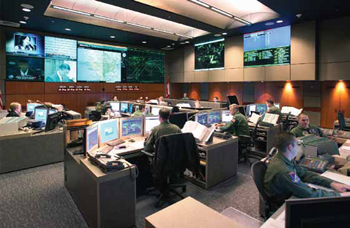
PESA equipment is in use at the CMD Command Center inside CheyenneMountain Air Force Station serving NORAD and USNORTHCOM.
Naturally, as integrators work to keep pace with video routing capabilities, they’ll also have to keep an eye on the next round of commercial video applications. PESA’s Holland points to high-definition security and surveillance systems as one of the next future-use possibilities to take a strong hold. “In the next few years, cameras and DVRs developed for the HDcctv Alliance transports—cameras based on HD-SDI data rates—will be tracking at about the same cost as Mega-pixel IP cameras,” he said. “This will allow compliant HDcctv video routing systems to be utilized for high definition security applications. Also, video routers will eventually evolve into multiviewer switchers—no matter what market segment, multiviewers and wall processors continue to be key elements in video routing systems. And integrated signal processing options to support embedded audio, bi-directional metadata, and port-agnostic connectivity will change the way routers are used in the future.”
Rose Electronics’ Macourek has his sights set on switching developments that will stem from the consumer world. “The three main screens that we utilize are the computer, the television, and the smart phone,” Macourek stated. “The tablet could even maybe be called a fourth screen. The use of these screens is spreading into the commercial market so that a video source may be routed to a tablet, or may be sent to someone’s screen across the world.”
All of which explains why video routing is becoming just one more in a series of grand convergences for systems integrators to master—while keeping it simple, of course. “AV routing is present everywhere, and there are no boundaries between consumer and commercial use,” PureLink’s Park said. “The industry must now deal with seamless integration with existing technology. Portable device integration is imminent as well. The AV market is being maximized to minimize human interaction.”
Picture Perfect
As know-how with digital video routing/switching increases, so does the number of tips and tricks that manufacturers can offer up to improve the odds of moving a perfect picture cleanly from Source A to Destination Z. PESA’s Dan Holland offered up these practical insights. “First, reduce the number of cable adapters and conversion gear as much as possible,” he suggested. “The simpler you can make the connection between source and destination, the better chance you have to reduce any latency and image degradation. Second, when you must use some type of signal format conversion gear, try to find one that can convert as many different formats as possible. This reduces the number of external devices, power connections, and adapter cabling needed when putting a system together. Third, look for a video control system that supports a wide range of control options: RS-232, ethernet, and web-based control are essential methods. Some control systems are very complicated and require a huge amount of training and support.”
“The quality of cabling is important to the project,” Rose’s Peter Macourek added. “Running spare wires can also be a good idea—it seems that you never can anticipate the need for a feature or piece of equipment. Where the equipment will be located and a clean source of power is also important.”
To Crestron’s Justin Kennington, the key to getting it correct is maintaining signal integrity. “Creating the right infrastructure for high-speed signals to travel on is crucial. Today, Crestron DigitalMedia is on its third generation of transmission media and each generation has performed to our own high standards— higher than those required by HDMI itself. We have focused our effort on making each generation perform as well as ever, while being easier to install and work with. Today, our 8G+ technology allows error-free transmission of uncompressed AV over standard Cat-5e cable—the cable that you probably already have in the wall.”
Meanwhile, PureLink’s Minsoo Park keeps the hazards of Extended Display Identification Data (EDID) in mind when offering up advice. “The majority of tech support for digital AV integration involves EDID management,” he explains. “Unlike analog AV systems, in digital AV systems there is no video without proper EDID handshake. PureLink’s EDID library and emulation feature Failsafe EDID capture and storage to provide constant and continuous EDID for source devices.”
—D.W.
Crestron CresFiber 8G

Crestron CresFiber 8G is graded-index multimode fiber optic cable with extended bandwidth for use with DigitalMedia 8G fiber solutions, as well as standard DigitalMedia fiber and Crestron HDMI over fiber. CresFiber 8G is graded-index multimode fiber optic cable engineered by Crestron to deliver extended bandwidth for the reliable installation of fiber-based Crestron systems. CresFiber 8G is tested to wavelengths up to 1,550 nm, surpassing the performance of previous generation CresFiber as well as generic OM2 and OM3. CresFiber 8G provides four individually jacketed fiber strands within a single reinforced outer jacket.
QVS CC388MA

The ultra-thin VGA/QXGA with stereo audio tri-shield, fully wired cable with interchangeable mounting from QVS allows installation in the tightest areas. The cable includes removable thumbscrews and that can be replaced with included stand-off screws and can be mounted on a face plate. It is fully-wired for maximum compatibility with both PC and HDTV/projector applications. The stereo audio cable color-coded connector extends 17 inches on one end and 22 inches on the other end.
Atlona LinkConnect
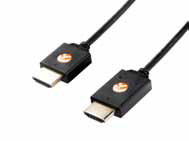
These cables utilize RedMere’s lowpower PRA1602 chips to transmit high speed HDMI with ethernet over an ultra-thin cable that is easily concealable in any commercial environment. The RedMere MagnifEye active technology eliminates the need for heavy-gauge copper, making the cables extremely light, thin, and portable. Atlona LinkConnect thin HDMI cables measure just 3 mm in diameter, making them approximately 65 percent thinner than normal HDMI cables.
Gepco SheerWire

SheerWire by Gepco Video Cables are made using the same techniques and materials used in professional, studio-grade video coax. Every SheerWire video cable is built to exacting electrical and mechanical specifications, then comprehensively tested and verified. As a result, the video image is transmitted with minimal loss or errors. SheerWire video cables include broadband, high-definition, and CCTV coax; component video RGB; as well as camera triax and low-skew UTP.
Clark CD Series

Clark Wire and Cable’s CD Series of HD/SDI coaxial cables for digital and high definition video formats are available in four sizes ranging from 23-gauge miniature to lowloss 14 gauge RG11 type coax. The CD series delivers broadcast-grade performance for demanding mobile production, studio, commercial AV, and large venue HD/SDI systems. Designed for precision electrical performance in high-bandwidth applications, the CD series delivers the critical electrical characteristics required for 1.5 Gb/s and 3 Gb/s uncompressed video transmission.
Extron LockIt
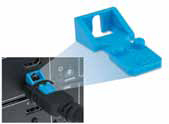
The Extron LockIt is a cable-lacing bracket for securing HDMI cables to the host product’s input and output connectors. The Extron LockIt provides a simple and inexpensive way to secure HDMI cable connections, helping to maintain signal integrity and streamline troubleshooting by ruling out loose cable connections as the source of the problem.
Gefen DisplayPort Extreme
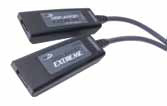
Gefen’s DisplayPort Extreme extenders come in pre-terminated lengths of 75 feet (23 m), 100 feet (30 m), 150 feet (45 m), 210 feet (64 m), and 300 feet (91m). Equipped on both ends with DisplayPort connectivity, these cables offer plug and play operability, using power to propel high-resolution video with audio up to 300 feet in distance. Both single or dual link video modes are supported up to 2,560 x 1,600 resolutions. The use of fiber optic components guarantees any resolution can be delivered in a pure digital format without compromising signal integrity. HDCP compliance is supported.
Cables To Go TruLink
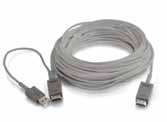
The TruLink high speed HDMI active optical cable (AOC) distributes high-definition AV from source to display in various commercial venues. The optical fiber construction between the connectors provides a flexible, durable cable assembly. It supports full 1080p resolution up to 20 meters and will be available in lengths up to 100 meters. The TruLink cable diameter is smaller and more flexible than copper, enabling easy installation for tight in-wall spaces.
DVI Gear DVI-D
Designed to overcome the barriers of sending digital DVI signals over copper wires, DVIGear’s extended length fiber optic cables provide signal fidelity and transparency over a range of input resolutions, with cables lengths up to 100 meters. These cables utilize high speed fiber-optic converters integrated within each connector that convert the digital input signals into optical pulses, and then back again at the display. The cable material is an innovative hybrid design consisting of four high-speed glass fibers and 5 copper wires, which offers a high degree of ruggedness and flexibility.
Liberty Optical Cables

Liberty AV’s active, optical HDMI high-speed cable assemblies offer quality and performance at distances of up to 328 feet (100 meters) without a need for conversion or additional power if the HDMI sink consumes 15 mA or less. Available in various lengths up to 328 feet, the high-speed cable assemblies draw power directly from any HDMI port. Utilizing both fiber optic and copper cabling in a UL-listed plenum configuration, the product line incorporates a design relying upon the ultra-miniaturization of the optical-to-electrical conversion process within the HDMI connector footprint.
Wiremold OFR Series

Designed for relocatable or permanent installations where access through floors and ceilings is not an option, the Wiremold OFR Series Overflow Raceway system provides four channels of capacity for AV connectivity. The overfloor raceway system attaches directly to floor covering, including carpet, tile, and wood. Installers do not have to remove or cut into existing floor coverings. The textured black powder coat finish resists scuffing and scratches, is paintable, and blends with many floor coverings. The raceway cover is difficult to remove without the proper tools, discouraging unwanted access. OFR Series Overflow
Belden 1694WB
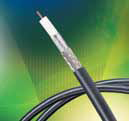
The 1694WB water blocking cable has a gel-filled layer on the braid that helps prevent water intrusion. The jacket is constructed from high-density black polyethylene, among the hardest jacket compounds available. This cable is appropriate for use underwater, in a hurricane, or any other application requiring super-ruggedness. The 1694WB takes the same stripping and crimping tools as regular 1694A, as well as the same connectors. The internal performance in high-definition or 3G (1080p/60), such as attenuation, effective distance, or return loss, is also the same as the 1694A.
Kramer DGKat

The DGKat series shielded twisted pair category cable from Kramer delivers HDMI and DVI digital video signals over long distances. DGKat are RoHS compliant and available in bulk spools of 1,000 feet and 328 feet. Three cable types are available: the BC-DGkat524, which is F/UTP constructed with 24 gauge conductors that have an overall outer shield; the BC-DGkat623, which is U/FTP designed with 23 gauge conductors where each pair is individually shielded; and BCP-DGkat724, an S/FTP designed, plenum rated cable constructed with 24 gauge conductors in individually shielded pairs and an overall outer shield.
David Weiss (www.dwords.com) writes extensively about AV, audio, and broadcast technology.
